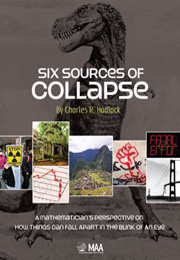
-
The digital format of this book is no longer available to purchase from Cambridge Core. Other formats may be available.
-
Select format
-
- Publisher:
- Mathematical Association of America
- Publication date:
- Invalid date
- December 2012
- ISBN:
- 9780883855799
- Dimensions:
- Weight & Pages:
- 00kg,
- Dimensions:
- Weight & Pages:
- Subjects:
- Mathematics, Mathematical Modeling and Methods
- Series:
- Spectrum
You may already have access via personal or institutional login- Subjects:
- Mathematics, Mathematical Modeling and Methods
- Series:
- Spectrum
Book description
Beginning with one of the most remarkable ecological collapses of recent time, that of the passenger pigeon, Hadlock goes on to survey collapse processes across the entire spectrum of the natural and man-made world. He takes us through extreme weather events, technological disasters, evolutionary processes, crashing markets and companies, the chaotic nature of Earth's orbit, revolutionary political change, the spread and elimination of disease, and many other fascinating cases. His key thesis is that one or more of six fundamental dynamics consistently show up across this wide range. These six sources of collapse can all be best described and investigated using fundamental mathematical concepts. They include low probability events, group dynamics, evolutionary games, instability, nonlinearity, and network effects, all of which are explained in readily understandable terms. Almost the entirety of the book can be understood by readers with a minimal mathematical background, but even professional mathematicians are likely to get rich insights from the range of examples. The author tells his story with a warmly personal tone and weaves in many of his own experiences, whether from his consulting career of racing around the world trying to head off industrial disasters to his story of watching collapse after collapse in the evolution of an ecosystem on his New Hampshire farm.
Contents
Metrics
Altmetric attention score
Full text views
Full text views help Loading metrics...
Loading metrics...
* Views captured on Cambridge Core between #date#. This data will be updated every 24 hours.
Usage data cannot currently be displayed.
Accessibility standard: Unknown
Why this information is here
This section outlines the accessibility features of this content - including support for screen readers, full keyboard navigation and high-contrast display options. This may not be relevant for you.
Accessibility Information
Accessibility compliance for the PDF of this book is currently unknown and may be updated in the future.


